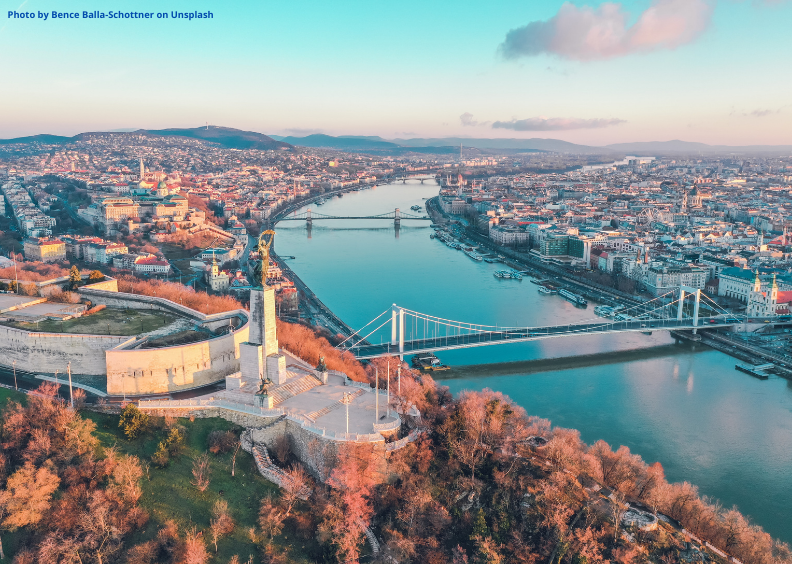Thank you for your message. The IPPA team will get back to you shortly. You first need to login here.

What to do in Budapest
If you are planning to join us in Budapest, this page will provide useful information to prepare for your trip. We will update it continuously, so do not hesitate to come back!
Preparing your trip to Budapest?
Check out our dedicated sections.
We update these sections regurlarly with the latest info.
Budapest
Budapest, the capital of Hungary. With a population of 2 million people, it is a beautiful city in the middle of Europe. The art nouveau-style architecture and the majestic buildings from the Austro-Hungarian Empire, a fascinating Turkish bath culture are only some of the reasons to visit Hungary’s capital, also known as the “Pearl of the Danube”. The city is also renowned for its food, with many great bars and restaurants. The locals are friendly, the city is safe and there are plenty of sites to visit for tourists.

What to see in Budapest
Széchenyi Chain Bridge
When it opened in 1849, Chain Bridge was unique for two reasons: it was the first link between Buda and Pest, and the nobility – previously exempt from all taxation – had to pay up like everybody else to use it.
It is the largest spa complex in Budapest (one of the biggest baths in Europe). The spa is located in the heart of City Park and is surrounded by many wonderful sights: you can visit nearby Heroe's Square, Vajdahunyad Castle, the Museum of fine arts, or even the Budapest Zoo and Botanical Garden. You can choose from 18 medicinal water pools, and can also try the outdoor adventure pool, hot tub, swimming pool or drift pool. There are both indoor and outdoor pools. The thermal bath is an excellent destination even in wintertime, so you can enjoy the beneficial hot water even when it’s freezing outside.
Basilica of St Stephen
Budapest’s neoclassical cathedral is the most sacred Catholic church in all of Hungary and contains its most revered relic: the mummified right hand of the church’s patron, King St Stephen. It was built over half a century to 1905. Much of the interruption during construction had to do with a fiasco in 1868 when the dome collapsed during a storm, and the structure had to be demolished and then rebuilt from the ground up. The view from the dome is phenomenal.
Take this opportunity to enjoy one of Budapest’s reputed rooftop bars (see the section below)
If motivated, a great alternative is to climb atop Gellért Hill to the The Liberty Monument for the same views at no cost.
The Royal Palace
Béla IV established a royal residence here in the mid-13th century, and subsequent kings added to the complex. The palace was levelled in the battle to drive out the Turks in 1686; the Habsburgs rebuilt it but spent very little time here. The Royal Palace now contains the Hungarian National Gallery, the Castle Museum, and the National Széchenyi Library. Facing the Royal Palace’s large courtyard to the northwest is the Romantic-style Matthias Fountain, portraying the young king Matthias Corvinus in hunting garb.
The Hungarian National Gallery
The HNG is an overwhelming collection spread across four floors and four wings of the palace that traces Hungarian art from the 11th century to the present day.
Nearby, the fairy-tale Fishermen’s Bastion provides a dazzling view over Pest across the river.
Matthias Church
Parts of the church date back 500 years, notably the carvings above the southern entrance, but essentially the church (named after King Matthias Corvinus who married Queen Beatrix here in 1474) is a neo-Gothic confection designed by the architect Frigyes Schulek in 1896.
The House of Houdini
Dedicated to the famous Hungarian-born magician and escape artist Harry Houdini, who was born Erik Weisz in Budapest's district VII in 1874, this small museum offers a cabinet of curiosities featuring original items from Houdini’s life, such as personal letters, handcuffs and documents, as well as props from the US 'Houdini' miniseries (2014). At the end of the guided tour, guests are treated to a live 15-minute magic performance.
Andrássy út
Listed by Unesco as a World Heritage Site in 2002, it is a tree-lined parade of knock-out architecture and is best enjoyed as a long stroll from the Hungarian State Opera House out to the park.
Full of fancy shops, cafes, restaurants and beautiful buildings, Andrássy Avenue is Budapest’s version of Paris’s Champs-Élysées. You’ll find the Hungarian State Opera House here – currently under renovation until 2020 – and the harrowing House of Terror Museum, the former headquarters of the secret police, where victims of cruel regimes were once tortured.
The Parliament
The Eclectic-style Parliament, designed by Imre Steindl and completed in 1902, has 691 sumptuously decorated rooms.
The Great Synagogue
Budapest's stunning Great Synagogue is the world's largest Jewish house of worship outside New York City. Built in 1859, the synagogue has both Romantic and Moorish architectural elements. Inside, the Hungarian Jewish Museum & Archives contains objects relating to both religious and everyday life. On the synagogue’s north side, the Holocaust Tree of Life Memorial presides over the mass graves of those murdered by the Nazis.
Margaret Bridge
For one of the prettiest panoramas of Budapest, stroll along yellow Margaret Bridge next to the Parliament. Halfway across, you’ll find the entrance to Margaret Island, the city’s biggest green oasis. The whole island is a huge park in the middle of the city with a Medieval church ruin, a gorgeous Japanese Garden and century-old towering trees.
Pesti Vigado
This Romantic-style concert hall, built in 1865 but badly damaged during WWII, faces the river to the west of Vörösmarty tér
Hospital in the Rock Nuclear Bunker Museum
Part of the Castle Hill caves network, this subterranean hospital was used extensively during the WWII siege of Budapest and during the 1956 Uprising. It contains original medical equipment as well as some 200 wax figures and is visited on a guided one-hour tour, which includes a walk through a Cold War–era nuclear bunker and an eight-minute introductory video.
Getting Around Budapest
BUDAPEST PUBLIC TRANSPORTS
Buses, trains, trams and subways are all reliable and run on time. Tram 4 and 6 runs 24/7 and covers most of central Budapest (there are checks even during the night, so best to have your ticket on you at all times.)
A ticket can be bought on the application BKK. A sibgle ticket cost 350 HUF (0.98€).
Here is a map on the Budapest subway.
BUDAPEST TAXI
You can also take cabs. Budapest Taxies are usually yellow and have a meter fitted. Prices are written on a card and should be visible at all times. Don't allow your driver to go without the meter running. Taxis fares to and from the Budapest Airport are fixed and should be around €26 (8000 HUF).
There is also Taxify which is the Uber alternative for Budapest. Download their app and book rides conveniently. Their drivers are usually very nice and professional. You should know the prices upfront and can pay via the app. It is customary to tip if you are satisfied with the service.
Different Taxi Services there:
Food, local dishes and places to see
Grab a Hungarian pastry from any bakery try a spiral shaped kakaós csiga (chocolate snail), a favourite of locals, typical for breakfast.
Goulash (gulyás) is one of the most famous dishes from the Hungarian culinary repertoire, yet even today there are severe misconceptions about the original version of this iconic food. Almost each region has its own variety, although a basic goulash is somewhere between a soup and stew, with beef (occasionally veal or pork), carrot, potato, spices and the typical paprika.
Fisherman’s soup (Halászlé) holds a similarly prominent place among the national dishes and, like goulash, it is cooked in a kettle over an open fire. The soup is prepared from mixed river fish (carp, catfish, perch or pike) and with a great amount of hot paprika, giving it the characteristic bright red color. It has numerous varieties, with a la Baja (made with thick pasta and mainly carp) or Szeged (made with four types of fish) being the most famous.
Try the sample Budapest’s best lángos, a disc-shaped deep-fried dough topped with sour cream, garlic and cheese – an all-time favourite in Hungary.
Főzelék is such a unique Hungarian dish it can’t be translated into English. Though it looks like a soup at first sight, a more accurate description might be a thick vegetable stew. Főzelék is one of the few healthy choices on the list of national dishes and, being practical and easy to make, it is a typical home-cooked dish.
For coffee and cake in the Castle District be sure to stop by Ruszwurm, the longest-running confectionery in Hungary – even the cafe’s counter is 200 years old. It’s always busy, so avoid prime lunchtime for your best chance of getting seats.
You can also get to the legendary Gundel Restaurant nearby, offering traditional Hungarian dishes with a modern twist. There, you can try the somlói galuska, the prestigious ‘Hungary’s favorite cake’. It's a delicious, unmissable dessert made from sponge cake, layered with chocolate cream, walnut kernel, rum and whipped cream on the top.
Try the special ice-cream skilfully made to resemble a rose from nearby Gelarto Rosa.
A visit to one of the city’s ruin bars is essential: The highest concentration of these ramshackle spots, adorned with skip-found furniture and random knick-knacks, can be found in District VII. Essential stop-offs include Szimpla Kert, the first ever ruin bar, and Ellátó Kert (Kazinczy u. 48), a dilapidated former meat processing facility with an expansive outdoor courtyard and eclectic music choice. Many people come to Budapest solely for the nightlife, so get lost in it; bar hop, meet locals and try your hand at local pub games.
Budapest is also well known for its rooftop bars: perenially 360 Bar is a good choice for those looking to party, while High Note is recommanded for an intimate evening.










